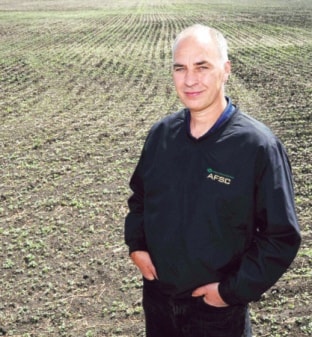As crops start to grow and another hail season gets underway, high commodity prices and input costs are raising the stakes for farmers this year, says Chris Dyck, with Agriculture Financial Services Corporation (AFSC).
“Hail is a threat every growing season in Alberta because we have one of the highest incidences of hail in the world. But when crop prices and inputs like fertilizer and seed climb as high as they are now – at well above average levels – hail becomes an even greater concern for farmers because they have so much invested in the ground,” says Dyck, senior manager of business risk management operations for AFSC. The Crown corporation provides the majority of hail Stakes are high for farmers, hail season begins insurance to farmers across Alberta on behalf of the provincial government.
As soon as crops emerge from the soil, they’re vulnerable, says Dyck. He points out a late-May hailstorm in southern Alberta has already triggered a few small claims under the AFSC Straight Hail program this spring. Last year, the first Straight Hail claim happened on June 4 in the Peace region.
“Crops have an amazing ability to rebound from early season hail damage,” says Dyck. “However, those early storms do often result in reduced plant stands and yields. The later hail strikes in the growing season, the greater the damage,” he adds, “because once plants have podded or headed out — usually by mid-July — it’s too late for recovery.”
AFSC paid out just over $25.5 million on nearly 1,500 Straight Hail claims last year — an average hail season for Alberta, says Dyck. The most severe damage was caused by two major hailstorms — one in early July that tore through crops from Sundre to Red Deer — and a second one on July 18 that cut a wide swath through fields from Millet to Saskatchewan. Several smaller storms also peppered crops with hail in almost every region of the province.
“Last year was a good example of the fact that hail strikes everywhere in Alberta, not just in the highest risk area known as Hail Alley that stretches from Calgary to Edmonton, along the Highway 2 corridor,” says Dyck.
What kind of hail season lies ahead this summer is anybody’s guess “If it’s wet and warm, we usually get more hail. If it’s dry, there’s generally less hail. But conditions can change so quickly, it’s impossible to predict,” he says, referring to the dry conditions experienced in 2009. “Parts of the province did end up getting moisture that summer, and we had hail losses of more than $30 million.
“An increasing number of farmers are taking out Straight Hail coverage in April with their crop insurance — before their fields are even planted,” says Dyck. “It’s an option we started offering two years ago for producers who want protection the instant their seeds are in the ground — rather than waiting for their crops to emerge and risk early hail damage.” Producers who take this ‘Auto Elect’ option receive a two-per-cent premium discount.
AFSC has been providing hail insurance to Alberta farmers on behalf of the provincial government for more than 70 years. It all started when the province passed special legislation in 1938 creating the Alberta Hail Insurance Board. The original hail program offered by the Hail Insurance Board still exists today and is administered by AFSC.
“Hail is risky business, and our mandate as a provincial insurer today is the same as it was back then – to provide hail insurance to farmers in every corner of the province, even in the highest risk townships,” says Dyck.
Submitted
